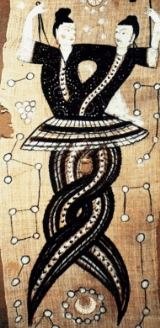
28th century BC
Encyclopedia
The 28th century BC is a century
which lasted from the year 2800 BC to 2701 BC.
Century
A century is one hundred consecutive years. Centuries are numbered ordinally in English and many other languages .-Start and end in the Gregorian Calendar:...
which lasted from the year 2800 BC to 2701 BC.
Events
- c. 2800 BC – 2700 BC: Seated Harp Player, from KerosKerosKeros is an uninhabited Greek island in the Cyclades about southeast of Naxos. Administratively it is part of the community of Koufonisi. It has an area of and its highest point is...
, CycladesCycladesThe Cyclades is a Greek island group in the Aegean Sea, south-east of the mainland of Greece; and a former administrative prefecture of Greece. They are one of the island groups which constitute the Aegean archipelago. The name refers to the islands around the sacred island of Delos...
, is made. It is now at the Metropolitan Museum of ArtMetropolitan Museum of ArtThe Metropolitan Museum of Art is a renowned art museum in New York City. Its permanent collection contains more than two million works, divided into nineteen curatorial departments. The main building, located on the eastern edge of Central Park along Manhattan's Museum Mile, is one of the...
, New YorkNew YorkNew York is a state in the Northeastern region of the United States. It is the nation's third most populous state. New York is bordered by New Jersey and Pennsylvania to the south, and by Connecticut, Massachusetts and Vermont to the east...
. - 2775 BC – 2650 BC: Second Dynasty wars in Ancient EgyptAncient EgyptAncient Egypt was an ancient civilization of Northeastern Africa, concentrated along the lower reaches of the Nile River in what is now the modern country of Egypt. Egyptian civilization coalesced around 3150 BC with the political unification of Upper and Lower Egypt under the first pharaoh...
. - Around 2773 - the 365-day calendar is introduced in Egypt.
- 2750 BC: End of the Early Dynastic I Period, and the beginning of the Early Dynastic II Period in MesopotamiaMesopotamiaMesopotamia is a toponym for the area of the Tigris–Euphrates river system, largely corresponding to modern-day Iraq, northeastern Syria, southeastern Turkey and southwestern Iran.Widely considered to be the cradle of civilization, Bronze Age Mesopotamia included Sumer and the...
. - c. 2750 BC: Estimated ending of the Cucuteni-Trypillian culture in the region of modern-day RomaniaRomaniaRomania is a country located at the crossroads of Central and Southeastern Europe, on the Lower Danube, within and outside the Carpathian arch, bordering on the Black Sea...
, MoldovaMoldovaMoldova , officially the Republic of Moldova is a landlocked state in Eastern Europe, located between Romania to the West and Ukraine to the North, East and South. It declared itself an independent state with the same boundaries as the preceding Moldavian Soviet Socialist Republic in 1991, as part...
, and southwestern UkraineUkraineUkraine is a country in Eastern Europe. It has an area of 603,628 km², making it the second largest contiguous country on the European continent, after Russia... - c. 2715 BC: Old KingdomOld KingdomOld Kingdom is the name given to the period in the 3rd millennium BC when Egypt attained its first continuous peak of civilization in complexity and achievement – the first of three so-called "Kingdom" periods, which mark the high points of civilization in the lower Nile Valley .The term itself was...
starts in Ancient EgyptEgyptEgypt , officially the Arab Republic of Egypt, Arabic: , is a country mainly in North Africa, with the Sinai Peninsula forming a land bridge in Southwest Asia. Egypt is thus a transcontinental country, and a major power in Africa, the Mediterranean Basin, the Middle East and the Muslim world...
(another date is 2660 BC).
Inventions, discoveries, introductions
- circa 2750 BC—Silbury HillSilbury HillSilbury Hill is a prehistoric artificial chalk mound near Avebury in the English county of Wiltshire. It is part of the Stonehenge, Avebury and Associated Sites UNESCO World Heritage Site, and lies at ....
begun - The Neolithic monument Stonehenge is built in England near Salisbury, Wiltshire, comprising a circular earthwork 97.5 m/320 ft in diameter with 56 small pits around the circumference (later known as the Aubrey holes). The position of the ‘heel stone’ outside the circle suggests a connection with Sun worship and observation. It is probably an astronomical observatory with religious functions; the motions of the Sun and Moon are followed with the aid of carefully aligned rocks. source:http://www.telusplanet.net/public/dgarneau/euro8.htm
- According to HerodotusHerodotusHerodotus was an ancient Greek historian who was born in Halicarnassus, Caria and lived in the 5th century BC . He has been called the "Father of History", and was the first historian known to collect his materials systematically, test their accuracy to a certain extent and arrange them in a...
, somewhere around 2750 BC, the city of Tyre was founded.

